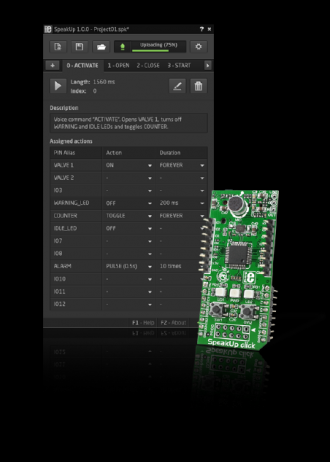
We strongly encourage users to use Package manager for sharing their code on Libstock website, because it boosts your efficiency and leaves the end user with no room for error. [more info]

Rating:
Author: MIKROE
Last Updated: 2016-02-18
Package Version: 1.0.0.0
Category: Audio & Speech
Downloaded: 588 times
Followed by: 3 users
License: MIT license
API for SpeakUp, the speech recognition click board
Do you want to subscribe in order to receive notifications regarding "SpeakUp API" changes.
Do you want to unsubscribe in order to stop receiving notifications regarding "SpeakUp API" changes.
Do you want to report abuse regarding "SpeakUp API".
| DOWNLOAD LINK | RELATED COMPILER | CONTAINS |
|---|---|---|
| 1433321836_speakup_api_other_other.rar [2.54MB] | Other Compiler |
|
The SpeakUp is a speech recognition click board. You can set it up to recognize over 200 different voice commands and have the on-board MCU carry them out instantly. The board comes with a free configuration tool that lets you easily record and assign individual commands. However, if you want to build your own configuration tool, you can do so with the SpeakUp API.
Whether you want to build a functionally similar interface but with a different look & feel, or you want to emphasize or de-emphasize certain aspects of the SpeakUp hardware, this API contains everything you need to start working:
- DLL files
- C header file with necessary declarations
- simple example written in c++
- help file with descriptions of interfaces and routines.
Please feel free to share your own SpeakUp software once you're done.

With the SpeakUp API, you can create your own SpeakUp configuration tool.
View full image